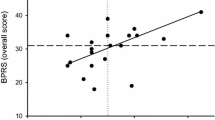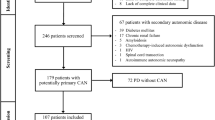Abstract
To assess whether among patients with Parkinson’s disease (PD) depression, a common non-motor symptom associated with reduced survival, is associated with cardiovascular dysautonomia. We enrolled 125 subjects with PD consecutively admitted to a geriatric day hospital. All participants underwent comprehensive evaluation, fasting blood sampling, and 24-h ambulatory blood pressure monitoring. The percent reduction in nocturnal blood pressure (dipping) was calculated. Depressive symptoms were assessed through the 15-item Geriatric Depression Scale (GDS); a score ≥5 identified moderate to severe symptoms. Among participants (mean age 72.7 ± 7.8 years, 32 % women) 61 subjects (49 %) presented with a GDS score ≥ 5. When compared with other participants, subjects with a GDS score ≥ 5 had reduced adjusted levels of percent systolic (−2.6 ± 2.7 vs. 4.7 ± 2.5; p = 0.003), diastolic (0.6 ± 2.8 vs. 7.4 ± 2.6; p = 0.007), and mean blood pressure dipping (−0.7 ± 2.6 vs. 6.8 ± 2.5; p = 0.002). In separate logistic regression models, depressive symptoms were associated with reduced systolic (OR 0.94; 95 % CI 0.89; 0.98), diastolic (OR 0.94; 95 % CI 0.90; 0.99), and mean blood pressure dipping (OR 0.93; 95 % CI 0.89; 0.98), after adjusting for potential confounders. Depressive symptoms are prevalent, and independently associated with cardiovascular dysautonomia among patients with Parkinson’s disease. This might explain the remarkable incidence of sudden death, as well as the association of depressive symptoms with reduced survival reported in these patients. The finding of depressive symptoms in subjects with Parkinson’s disease should therefore prompt assessment of cardiovascular autonomic function.

Similar content being viewed by others
References
Velseboer DC, Broeders M, Post B et al (2013) Prognostic factors of motor impairment, disability, and quality of life in newly diagnosed PD. Neurology 80(7):627–633
Barone P, Antonini A, Colosimo C et al (2009) PRIAMO study group. The PRIAMO study: a multicenter assessment of nonmotor symptoms and their impact on quality of life in Parkinson’s disease. Mov Disord 24(11):1641–1649. doi:10.1002/mds.22643
Laudisio A, Vetrano DL, Meloni E et al (2014) Dopaminergic agents and nutritional status in Parkinson’s disease. Mov Disord 29(12):1543–1547. doi:10.1002/mds.25991
Jain S (2011) Multi-organ autonomic dysfunction in Parkinson’s disease. Parkinsonism Relat Disord 17(2):77–83
Dickson DW, Fujishiro H, Orr C et al (2009) Neuropathology of non-motor features of Parkinson disease. Parkinsonism Relat Disord 15(Suppl 3):S1–S5
Asahina M, Vychanrat E, Low DA et al (2013) Autonomic Dysfunction in parkinsonian disorders: assessment and pathophysiology. J Neurolg Neurosurg Psychiatry 84(6):674–680
Stuebner E, Vichayanrat E, Low DA et al (2013) Twenty-four hour non invasive ambulatory blood pressure monitoring in Parkinson’s disease. Front Neurol 4:49. doi:10.3389/fneur.2013.00049
Ravina B, Camicioli R, Como PG et al (2007) The impact of depressive symptoms in early Parkinson disease. Neurology 69(4):342–347
Hughes TA, Ross HF, Mindham RH et al (2004) Mortality in Parkinson’s disease and its association with dementia and depression. Acta Neurol Scand 110(2):118–123
Sagna A, Gallo JJ, Pontone GM (2014) Systematic review of factors associated with depression and anxiety disorders among older adults with Parkinson’s disease. Parkinsonism Relat Disord 20:708–715
Hughes AJ, Daniel SE, Kilford L et al (1992) Accuracy of clinical diagnosis of idiopathic Parkinson’s disease. A clinico-pathological study of 100 cases. JNNP 55:181–184
Almeida OP, Almeida SA (1999) Short versions of the geriatric depression scale: a study of their validity for the diagnosis of a major depressive episode according to ICD-10 and DSM-IV. Int J Geriatr Psychiatry 14(10):858–865
Friedman B, Heisel MJ, Delavan RL (2005) Psychometric properties of the 15-item geriatric depression scale in functionally impaired, cognitively intact, community-dwelling elderly primary care patients. J Am Geriatr Soc 53(9):1570–1576
Tomlinson CL, Stowe R, Patel S et al (2010) Systematic review of levodopa dose equivalency reporting in Parkinson’s disease. Mov Disord 25(15):2649–2653
Van Den Eeden SK, Tanner CM, Bernstein AL, Fross RD, Leimpeter A, Bloch DA, Nelson LM (2003) Incidence of Parkinson’s disease: variation by age, gender, and race/ethnicity. Am J Epidemiol 157(11):1015–1022
Berrios GE, Campbell C, Politynska BE (1995) Autonomic failure, depression and anxiety in Parkinson’s disease. Br J Psychiatry 166:789–792
Dissanayaka NN, Sellbach A, Silburn PA et al (2011) Factors associated with depression in Parkinson’s disease. J Affect Disord 132(1–2):82–88. doi:10.1016/j.jad.2011.01.021
Ravina B, Elm J, Camicioli R et al (2009) The course of depressive symptoms in early Parkinson’s disease. Mov Disord 24(9):1306–1311. doi:10.1002/mds.22572
Pachana NA, Egan SJ, Laidlaw K et al (2013) Clinical issues in the treatment of anxiety and depression in older adults with Parkinson’s disease. Mov Disord 28(14):1930–1934. doi:10.1002/mds.25689
Remy P, Doder M, Lees A et al (2005) Depression in Parkinson’s disease: loss of dopamine and noradrenaline innervation in the limbic system. Brain 128:1314–1322
Frisina PG, Haroutunian V, Libow LS (2009) The neuropathological basis for depression in Parkinson’s disease. Parkinsonism Relat Disord 15(2):144–148. doi:10.1016/j.parkreldis.2008.04.038
Menza M, Dobkin RD, Dicke A (2009) A controlled trial of antidepressants in patients with Parkinson’s disease. Neurology 72(10):886–892
Rektorova I, Rektor I, Bares M et al (2013) Pramipexole and Pergolide in treatment of depression in Parkinson’s disease: a national multicentre prospective randomized study. Eur J Neurol 10(4):399–406
Braak H, Ghebremedhin E, Rüb U et al (2004) Stages in the development of Parkinson’s disease-related pathology. Cell Tissue Res 318:121–134
Comi C, Magistrelli L, Oggioni GD et al (2014) Peripheral nervous system involvement in Parkinson’s disease: evidence and controversies. Parkinsonism Relat Disord 20(12):1329–1334. doi:10.1016/j.parkreldis.2014.10.010
Drago S, Bergerone S, Anselmino M et al (2007) Depression in patients with acute myocardial infarction: influence on autonomic nervous system and prognostic role. Results of a five-year follow-up study. Int J Cardiol 115(1):46–51
Matsumoto H, Sengoku R, Saito Y et al (2014) Sudden death in Parkinson’s disease: a retrospective autopsy study. J Neurol Sci 343(1–2):149–152. doi:10.1016/j.jns.2014.05.060
Ishizaki F, Harada T, Yoshinaga H et al (1996) Prolonged QTc intervals in Parkinson’s disease–relation to sudden death and autonomic dysfunction. No To Shinkei 48(5):443–448
Nakamoto T, Matsukawa K, Liang N et al (2011) Coactivation of renal sympathetic neurons and somatic motor neurons by chemical stimulation of the midbrain ventral tegmental area. J Appl Physiol 110(5):1342–1353. doi:10.1152/japplphysiol.01233.2010
Murata Y, Harada I, Ishizaki F et al (1997) Autonomic dysfunction in Parkinson’s disease and vascular parkinsonism. Acta Neurol Scand 96:359–365
Vriend C, Raijmakers P, Veltman DJ et al (2014) Depressive symptoms in Parkinson’s disease are related to reduced [123I]FP-CIT binding in the caudate nucleus. J Neurol Neurosurg Psychiatry 85(2):159–164. doi:10.1136/jnnp-2012-304811
Author information
Authors and Affiliations
Corresponding author
Ethics declarations
Conflicts of interest
None.
Ethical standard
The present non-interventional study has been carried out in agreement with the 1964 Declaration of Helsinki.
Rights and permissions
About this article
Cite this article
Vetrano, D.L., Pisciotta, M.S., Lo Monaco, M.R. et al. Association of depressive symptoms with circadian blood pressure alterations in Parkinson’s disease. J Neurol 262, 2564–2571 (2015). https://doi.org/10.1007/s00415-015-7887-0
Received:
Revised:
Accepted:
Published:
Issue Date:
DOI: https://doi.org/10.1007/s00415-015-7887-0




